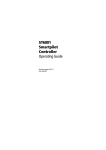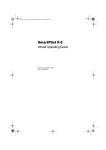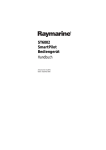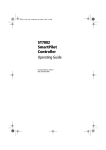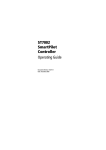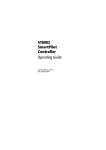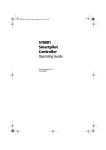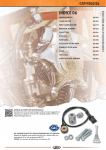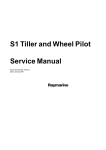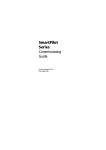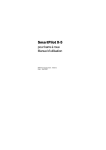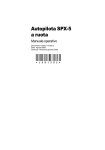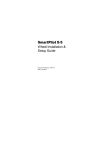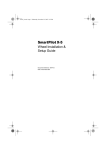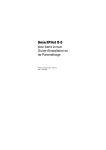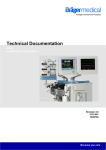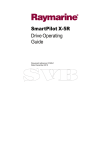Download Raymarine S1 Tiller Pilot
Transcript
81283_1.book Page i Monday, October 2, 2006 2:16 PM SmartPilot Series S1WheelPilot S1 TillerPilot Operating Guide Document reference: 812831 Date: October 2006 81283_1.book Page ii Monday, October 2, 2006 2:16 PM Autohelm, HSB (High Speed Bus), SailPilot, SeaTalk and SportPilot are registered trademarks of Raymarine Ltd. Raymarine, AST (Advanced Steering Technology), AutoAdapt, AutoLearn, AutoRelease, AutoSeastate, AutoTack, AutoTrim, FastTrim, GyroPlus, RayGyro, RayPilot and WindTrim are trademarks of Raymarine Ltd. Raymarine and SeaTalk are trademarks of Raymarine Ltd Handbook contents © Raymarine Ltd. 2005. 81283_1.book Page i Monday, October 2, 2006 2:16 PM i Important Information About the documentation provided Welcome to Raymarine SmartPilot. The autopilot system that will steer your boat to a heading automatically, accurately, reliably and comfortably. SmartPilot documentation is arranged so that you can install, commission and quickly use your SmartPilot, keeping to hand only the information necessary. • Installation Sheets One per element of the system, these easy to under stand sheets guide you through the installation process. These can be dis carded once the installation is complete. • SmartPilot Commissioning Guide Describes how to connect, commis sion and configure the system. Supplied with systems only. • Quick Start Guide Once commissioned, use your Smart Pilot right away with this handy guide to the main operations. • Operating Guide This handbook. Contains a detailed description of the SmartPilot’s features and functions. Warranty To register your new Raymarine product, please take a few minutes to fill out the warranty card. It is important that you complete the owner information and return the card to us to receive full warranty benefits. You can also register online at www.raymarine.com Safety notices WARNING: Calibration We supply this product calibrated to default settings that should provide initial stable performance for most boats. To ensure optimum performance on your boat, you must complete the procedures in SmartPilot Commissioning Guide before use. WARNING: Navigation aid Although we have designed this product to be accurate and reliable, many factors can affect its performance. As a result, it should only be used as an aid to navigation and should never replace common sense and navigational judgement. Always maintain a permanent watch so you can respond to situations as they develop. 81283_1.book Page ii Monday, October 2, 2006 2:16 PM ii S1 Wheel and Tiller Pilots Operating Guide Your Raymarine SmartPilot will add a new dimension to your boating enjoyment. However, it is the skipper’s responsibility to ensure the safety of the boat at all times by following these basic rules: • Ensure that someone is present at the helm AT ALL TIMES, to take manual control in an emergency. • Make sure that all members of crew know how to disengage the autopilot. • Regularly check for other boats and any obstacles to navigation – no matter how clear the sea appears, a dangerous situation can develop rapidly. • Maintain an accurate record of the boat’s position by using either a naviga tion aid or visual bearings. • Maintain a continuous plot of your boat’s position on a current chart. Ensure that the locked autopilot heading will steer the boat clear of all obstacles. Make proper allowance for tidal set – the autopilot cannot. • Even when your autopilot is locked onto the desired track using a navigation aid, always maintain a log and make regular positional plots. Navigation sig nals can produce significant errors under some circumstances and the autopi lot will not be able to detect these errors. Product disposal Waste Electrical and Electronic (WEEE) Directive The WEEE Directive requires the recycling of waste electrical and electronic equipment. Whilst the WEEE Directive does not apply to some of Raymarine's products, we support its policy and ask you to be aware of how to dispose of this product. The crossed out wheelie bin symbol, illustrated above, and found on our products signifies that this product should not be disposed of in general waste or landfill. Please contact your local dealer, national distributor or Raymarine Technical Services for information on product disposal. EMC Conformance All Raymarine equipment and accessories are designed to the best industry standards for use in the recreational marine environment. Their design and manufacture conforms to the appropriate Electromagnetic Compatibility (EMC) standards, but correct installation is required to ensure that performance is not compromised. 81283_1.book Page iii Monday, October 2, 2006 2:16 PM Important Information iii Handbook information To the best of our knowledge, the information in this handbook was correct when it went to press. However, Raymarine cannot accept liability for any inaccuracies or omissions it may contain. In addition, our policy of continuous product improvement may change specifications without notice. As a result, Raymarine cannot accept liability for any differences between the product and the handbook. 81283_1.book Page iv Monday, October 2, 2006 2:16 PM iv S1 Wheel and Tiller Pilots Operating Guide 81283_1.book Page v Monday, October 2, 2006 2:16 PM v Contents Important Information ................................................................................................. i About the documentation provided ........................................................................ i Warranty ................................................................................................................. i Safety notices .......................................................................................................... i WARNING: Calibration ................................................................................. i WARNING: Navigation aid .......................................................................... i Product disposal ..................................................................................................... ii EMC Conformance ................................................................................................. ii Handbook information .......................................................................................... iii Contents ................................................................................................................ v Chapter 1: Basic operation .......................................................................................... 1 1.1 Introduction ..................................................................................................... 1 SmartPilot Functions ........................................................................................ 1 Extended systems............................................................................................. 2 1.2 Using the control unit ....................................................................................... 3 Switching on and off......................................................................................... 3 Startup mode .......................................................................................... 3 Keypad functions .............................................................................................. 3 What does the display tell me? ......................................................................... 5 1.3 Using the SmartPilot to steer your boat ............................................................ 6 CAUTION: Maintain a permanent watch ................................................. 6 CAUTION: Risk of gybe................................................................................... 6 How do I automatically steer to a heading?...................................................... 6 WARNING: Wheel drive clutch.................................................................. 6 How do I return to hand steering? .................................................................... 7 CAUTION: ...........................................................Wheel drive systems7 How do I change course in Auto mode?............................................................ 7 Can I dodge an obstacle and then resume course? ........................................... 8 Off Course alarm............................................................................................... 9 1.4 How do I adjust the performance of my SmartPilot? ........................................ 9 1.5 Sailing functions ............................................................................................ 11 Tacking (AutoTack) ......................................................................................... 11 CAUTION: Allow time for course changes ............................................ 11 AutoTack angle ...................................................................................... 12 Preventing gybes with AutoTack............................................................ 12 Gusty conditions............................................................................................. 13 CAUTION: Risk of gybe................................................................................. 13 1.6 Display lighting & contrast? ........................................................................... 14 Adjusting the display lighting ......................................................................... 14 81283_1.book Page vi Monday, October 2, 2006 2:16 PM vi S1 Wheel and Tiller Pilots Operating Guide Adjusting the contrast.....................................................................................14 Chapter 2: Advanced operation ...............................................................................17 2.1 How do I follow a route set on a Chartplotter? ...............................................17 How do I activate Track mode?........................................................................17 CAUTION: Make suitable preparations for entering track mode .17 How do I leave Track mode?............................................................................18 Cross track error?............................................................................................18 CAUTION: The direction of turn and the displayed bearing to way point may be different from that expected. .......................................19 Tidal stream compensation .............................................................................20 How do I dodge an obstacle in Track mode?....................................................21 What happens when I arrive at a waypoint? ...................................................21 How do I skip a waypoint? (SeaTalk chartplotters) ................................ 22 WARNING: Ensure navigation safety22 What is the Waypoint Advance alarm? ................................................. 22 What happens when I get to the end of the route?..........................................22 2.2 Using Wind Vane mode ..................................................................................23 What is Wind Vane mode? ..............................................................................23 Wind information............................................................................................23 True and apparent wind......................................................................... 23 WindTrim ............................................................................................... 23 How do I select Wind Vane mode? ..................................................................24 How do I leave Wind Vane mode?...................................................................24 How do I dodge an obstacle in Wind Vane mode?...........................................25 What is a Wind Shift warning? ........................................................................25 How do I use AutoTack in Wind Vane mode? ..................................................25 AutoTack angle ...................................................................................... 26 Operating hints for Wind Vane mode ..............................................................26 2.3 How do I display boat data? ...........................................................................27 Can I display Waypoint names?.......................................................................27 2.5 User Calibration Options ................................................................................30 How do I access User Calibration settings? .....................................................30 User Calibration pages....................................................................................30 AutoTack angle ...................................................................................... 30 Gybe inhibit............................................................................................ 30 Wind selection ................................................................................................31 WindTrim ............................................................................................... 31 Response level ....................................................................................... 31 Chapter 3: Fault Finding & Maintenance ...............................................................33 3.1 Fault finding ...................................................................................................33 SmartPilot alarm messages.............................................................................34 3.2 General maintenance .....................................................................................36 81283_1.book Page vii Monday, October 2, 2006 2:16 PM vii Routine checks................................................................................................ 36 CAUTION: Do not dismantle SmartPilot products ............................. 36 Cleaning the display ....................................................................................... 36 CAUTION: Avoid damage when cleaning .............................................. 36 Wheel drive..................................................................................................... 37 Routine maintenance ............................................................................. 37 Cleaning the wheel drive ....................................................................... 37 CAUTION: ......................................................................................................... 37 Adjusting the clutch ............................................................................... 37 Replacing the belt .................................................................................. 38 User serviceable parts ............................................................................ 38 EMC advice..................................................................................................... 39 Product support.............................................................................................. 39 World wide web..................................................................................... 39 Telephone help line................................................................................ 40 Help us to help you ................................................................................ 40 Product details table .............................................................................. 41 Specifications ................................................................................................................ 43 ST6002 control unit .............................................................................................. 43 SmartPilot computer functions ............................................................................. 43 Glossary ........................................................................................................................... 44 Index ................................................................................................................................. 47 81283_1.book Page viii Monday, October 2, 2006 2:16 PM viii S1 Wheel and Tiller Pilots Operating Guide 81283_1.book Page 1 Monday, October 2, 2006 2:16 PM 1 Chapter 1: Basic operation 1.1 Introduction DIS P STA ND -1 BY +1 -10 TR AC K 10 AU TO D87 27- 1 The SmartPilot controller is a SeaTalk® compatible autopilot control unit. It is designed as the main controller for the SmartPilot system. The SmartPilot controller operates in the following modes: • Standby: SmartPilot off. You have manual control of the boat. • Auto: The SmartPilot steers the boat to maintain a locked heading. • Track: The SmartPilot steers the boat to maintain a track between two way points created on a navigation aid. • Wind Vane: The SmartPilot steers the boat to maintain a course relative to a true or apparent wind angle. The SmartPilot controller also provides: • automatic tack (AutoTack) in Auto and Wind Vane modes. • waypoint advance feature in Track mode. SmartPilot Functions The functions provided with your SmartPilot system depend on whether the SmartPilot computer contains a GyroPlus yaw sensor to measure the boat’s rate of turn. 81283_1.book Page 2 Monday, October 2, 2006 2:16 PM 2 S1 Wheel and Tiller Pilots Operating Guide • • has a built in Gyro. S1 WheelPilot does not contain a builtin Gyro. This can be upgraded with a dealerfitted Gyro plus unit to give the same func tionality as the S1 TillerPilot. Table 11: S1 TillerPilot : S1 TillerPilot S1 WheelPilot (with GyroPlus) (without GyroPlus) Internal GyroPlus yaw sensor provides Full basic functionality: uses Rayma enhanced course keeping using AST rine steering algorithm without AST (Advanced Steering Technology) Steering to true and apparent wind in Steering to true and apparent wind in Wind Vane mode Wind Vane mode Equipped with AutoLearn, Rayma rine’s selflearning calibration system Extended systems You can connect the SmartPilot controller to other Raymarine SeaTalk equipment so it can send and receive SeaTalk data: • it can use waypoint information from a SeaTalk navigation instrument to pro vide track control. • it can use boat speed from a SeaTalk speed instrument to optimize trackkeep ing performance. • it can use wind information from a SeaTalk wind instrument for Wind Vane steering. You can also use the SmartPilot with any navigator or wind instrument that transmits National Marine Electronics Association (NMEA) 0183 data. The SmartPilot control unit can display SeaTalk and NMEA instrument data in a userdefined selection of data pages. For further information on other connections to your system see SmartPilot Commissioning Guide. 81283_1.book Page 3 Monday, October 2, 2006 2:16 PM Chapter 1: Basic operation 1.2 3 Using the control unit Switching on and off All the time that power is applied to the SmartPilot controller, you can use the disp button to switch the instrument off and on as follows: • To switch the SmartPilot controller off, ensure it is in the Standby mode, then hold down the disp button for approximately 5 seconds. After this time, a switch off count down of 4 seconds occurs. Keep the disp button pressed during this period, to switch off the instrument. • To switch the instrument back on, hold down the disp button for approx imately 1 second. When the power supply is switched off, the SmartPilot controller buttons have no effect. Notes: (1) (2) Each time power to the SmartPilot controller is switched on, the controller is initially in the on condition. You do not need to use the disp button to switch the controller on. When the SmartPilot controller is on, the operation of the disp button will perform other operating functions, as described below. Startup mode The SmartPilot always powers up in Standby mode with the display showing the boat’s current compass heading. Keypad functions The SmartPilot is controlled using simple pushbutton operations, all of which are confirmed with a short beep. In addition to the main singlebutton functions, there are several dualbutton operations. 81283_1.book Page 4 Monday, October 2, 2006 2:16 PM 4 S1 Wheel and Tiller Pilots Operating Guide -1 plus -10 Press together for AutoTack to port DISP Press to display data pages Press for 1 second for lamp adjust Press for 3 seconds for contrast adjust Press for 9 seconds (in Standby mode) for power down When powered down, press for 1 second to power up STANDBY Press for Standby mode Press for 2 seconds to enter Calibration mode -1 plus +1 Press for Response level Press for 1 second for Rudder Gain +1 plus +10 Press together for AutoTack to starboard TRACK Press for Track mode from Auto (if a navigator is connected) Press to accept waypoint advance Press for 1 second to skip waypoint Course change keys Port 1˚ Starboard 1˚ Port 10˚ Starboard 10˚ STANDBY plus AUTO Press for Wind Vane mode (if a wind vane is connected) AUTO Press for Auto mode D5449-3 81283_1.book Page 5 Monday, October 2, 2006 2:16 PM Chapter 1: Basic operation 5 What does the display tell me? The SmartPilot display screen provides the following information: Variable text region (up to 9 characters/digits) nm SM MAG TRUE Distance units: • no units = kilometres • nm = nautical miles • SM = statute miles Heading indicators Port and Starboard direction-to-steer indicators Rudder position indicator D5457-3 The bar graph is used on S1 WheelPilot systems to indicate the current position of the rudder, as measured by the rudder position sensor. This may be turned on/off using the display calibration settings (See your commissioning guide for more details). 81283_1.book Page 6 Monday, October 2, 2006 2:16 PM 6 S1 Wheel and Tiller Pilots Operating Guide 1.3 Using the SmartPilot to steer your boat CAUTION: Maintain a permanent watch Automatic course control makes it easier to sail a boat, but it is NOT a substitute for good seamanship. ALWAYS maintain a permanent watch by the helm. CAUTION: Risk of gybe Always be aware of the relative wind angle, especially when using the autopilot to sail down wind. How do I automatically steer to a heading? 1. Steady the boat on the required heading. 2. Wheel Pilot: Engage the wheel drive clutch by rotating the clutch lever clockwise (so the lever engages fully onto the locating pip). Tiller Pilot: Place the pushrod end over the tiller pin. If necessary, extend or retract the pushrod using the 1, +1, 10 and +10 keys. WARNING: Wheel drive clutch Always reach AROUND (not through) the wheel to operate the wheel drive clutch lever. Wheel pilot Engage the clutch on the wheel pilot Tiller pilot a b Use these keys to extend or retract the pushrod. Speed: +1 = 25%, +10 = 50% D5341-2 Note: This function is not intended for steering the boat. 81283_1.book Page 7 Monday, October 2, 2006 2:16 PM Chapter 1: Basic operation 7 3. Press auto. The SmartPilot is now in AUTO mode and will steer to the chosen heading, shown on the display. This mode is often known as “pointandshoot”. TRUE D3560-6 How do I return to hand steering? 1. Press standby to disengage the SmartPilot: • in STANDBY mode, you have manual control of the boat and the display shows the boat’s current compass heading. TRUE D3561-6 2. Disengage the autopilot to return to hand steering: • Wheel Pilot: Disengage the wheel drive clutch by rotating the clutch lever anticlockwise (so the lever engages fully onto the locating pip). • Tiller Pilot: Remove the drive unit from the tiller pin. If required, retract the push rod using 1, +1, 10 and +10 keys. CAUTION: Wheel drive systems On wheel drive systems, always make sure that the clutch is FULLY DISENGAGED before you leave the boat. How do I change course in Auto mode? In Auto mode, use the 1 and 10 (port) and +1 and +10 (starboard) buttons to change the locked heading in steps of 1° or 10°. For example: press 10 three times for a 30° course change to port. 81283_1.book Page 8 Monday, October 2, 2006 2:16 PM 8 S1 Wheel and Tiller Pilots Operating Guide Port Starboard or or D3320-3 Can I dodge an obstacle and then resume course? To avoid an obstacle when your boat is under autopilot control, you can dodge the obstacle and then resume your previous course. Obstacle Original course Dodge D3303-3P 1. Select a course change in the appropriate direction. For example, press 10 three times for a 30°dodge to port. 2. When safely clear of the obstacle either: i. press and hold AUTO for 2 seconds to return to the previous heading, or ii. reverse the previous course change (for example, press +10 three times). 81283_1.book Page 9 Monday, October 2, 2006 2:16 PM Chapter 1: Basic operation 9 Off Course alarm = deviation to port = deviation to starboard D3315-5 The SmartPilot warns you when you have been off course from the locked heading for longer than 20 seconds. It shows whether the deviation is to port or starboard. The warning automatically clears if the heading recovers or if you change course. 1. To cancel the off course warning, press standby to return to manual steer ing. 2. Check whether your boat is carrying too much sail, or whether the sails are badly balanced. You can usually significantly improve course keeping by improving the sail balance. The default off course angle is set at 20º. You can adjust this angle in Dealer Cali bration (see SmartPilot Commissioning Guide). Note: 1.4 How do I adjust the performance of my SmartPilot? The principal method of adjusting the performance of SmartPilot systems is by changing the response level. This is the only user adjustment you should need to make to your SmartPilot on a regular basis. The response level controls the relationship between the SmartPilot’s course keeping accuracy and the amount of helm/drive activity. When you turn on your SmartPilot it will always be at the default level. (This level can be adjusted in User Calibration When you require extra tight course keeping (e.g. for pilotage in confined and sheltered waters), increase the setting. If you want to minimize drive activity and conserve battery power, decrease the setting. You can make temporary adjustments to the response level when using your SmartPilot on a daytoday basis. By doing this you can match performance to conditions as they occur. see page 31) 81283_1.book Page 10 Monday, October 2, 2006 2:16 PM 10 S1 Wheel and Tiller Pilots Operating Guide You will lose these temporary changes to response level whenever the system is powered off. You can make permanent adjustments in User Calibration (See page 31). This determines the default powerup response level. Note: Adjusting performance TillerPilot (and gyro upgraded WheelPilot) S1 TillerPilot (and gyro upgraded WheelPilot) systems have 9 levels of response: • level 9 to 7 give the tightest course keeping and greatest rudder activity (and power consumption). This can lead to a rough passage in open waters as the SmartPilot may ‘fight’ the sea. • levels 6 to 4 should give good course keeping with crisp, well controlled turns under normal operating conditions. • level 3 to 1 minimizes the amount of pilot activity. This conserves power, but may compromise shortterm coursekeeping accuracy. With these points in mind, you should use the following procedure to make temporary adjustments to the response level when required: 1. Display the RESPONSE screen by pressing the 1 and +1 buttons together momentarily. Note: The RESPONSE screen is set as a default data page (see SmartPilot Commis sioning Guide) so you can also access it by pressing disp and then scrolling through the data pages. 2. Press 1 or +1 buttons to change the response level. Decrease response Increase response D5452-3 3. Press disp or wait for 5 seconds to return to the previous display. 81283_1.book Page 11 Monday, October 2, 2006 2:16 PM Chapter 1: Basic operation 11 Adjusting performance S1 WheelPilot (without gyro) S1 WheelPilot systems (without a gyro upgrade) have three different response levels: • Response Level 1: AutoSeastate on (Automatic deadband) The SmartPilot will gradually ignore repetitive boat movements and only react to true variations in course. This provides the best compromise between power consumption and course keeping accuracy. • Response Level 2: AutoSeastate off (Minimum deadband) This setting provides tighter course keeping but will lead to increased power consumption and drive unit activity. • Response Level 3: AutoSeastate off + yaw damping This setting provides the tightest possible course keeping by introducing counter rudder yaw damping You can adjust the counter rudder setting in Dealer Calibration (see SmartPilot Commissioning Guide). To make a temporary change to the response setting: 1. Display the RESPONSE screen by pressing the 1 and +1 buttons together. 2. Press 1 or +1 buttons to change the response between levels 1 to 3. 3. Press disp or wait for 5 seconds to return to the previous display. You will lose these temporary changes to response level whenever the system is powered off. You can make permanent adjustments in User Calibration (see page 31). Note: 1.5 Sailing functions Tacking (AutoTack) CAUTION: Allow time for course changes When making major course changes, the trim on the boat may change substantially. Due to this, the SmartPilot may take some time to settle accurately onto the new course. The SmartPilot has a built in automatic tack facility (AutoTack) that turns the boat in the required direction for a tacking maneuver. When you AutoTack the boat turns through the AutoTack angle (100° default). You should then trim the helm to mirror the wind angle from the previous tack. • To AutoTack to port i. Press the 1 and 10 buttons together. The boat will then AutoTack. ii. Use the +1 and +10 buttons to trim the helm back to the required wind angle. 81283_1.book Page 12 Monday, October 2, 2006 2:16 PM 12 S1 Wheel and Tiller Pilots Operating Guide • To AutoTack to starboard: i. Press the +1 and +10 buttons together. The boat will then AutoTack. ii. Use the 1 and 10 buttons to trim the helm back to the required wind angle. AutoTack - Port AutoTack - Starboard Helm trim Helm trim Wind Wind + AutoTack Helm trim Helm trim + AutoTack angle AutoTack angle + AutoTack + D9318-1 AutoTack angle You should set the AutoTack angle to 20° greater than the actual required change of heading. Example If you wish to tack through 80° (i.e when sailing at 40° to the wind) you should set the AutoTack angle to 100°. The SmartPilot will AutoTack through the larger angle, you should then use the SmartPilot controls to trim the helm back to the required 40° relative to the wind. You can adjust the default AutoTack angle in User Calibration (see ). page 30 Preventing gybes with AutoTack The gybe inhibit feature prevents an AutoTack away from the wind – this will prevent the AutoTack feature from gybing. Note: tion. For the gybe inhibit feature to work, the SmartPilot needs suitable wind informa Gybe inhibit is switched on as a default but can be disabled in User Calibration if required (see page 30). 81283_1.book Page 13 Monday, October 2, 2006 2:16 PM Chapter 1: Basic operation 13 With gybe inhibit on: • you will be able to perform an AutoTack into the wind. • the autopilot will prevent the boat from performing an AutoTack away from the wind, to prevent accidental gybes. With gybe inhibit off: • you can perform an AutoTack into or away from the wind. Gybe inhibit is switched on as a default but can be disabled in User Calibration (see page 30). Note: Gusty conditions CAUTION: Risk of gybe Always be aware of the relative wind angle, especially when using the Autopilot to sail down wind. In gusty conditions, the course may tend to wander slightly, particularly if the sails are badly balanced. If you take the following precautions, the SmartPilot will be able to maintain competent control even in gale force conditions: • You can improve course keeping by improving the sail balance: • do not allow the boat to heel over excessively. • ease the mainsheet traveller to leeward to reduce heeling and weather helm. • if necessary, reef the mainsail a little early. • In very strong winds and large seas, you should avoid sailing with the wind dead astern: • ideally, bring the wind at least 30° away from a dead run. • in severe conditions, you may also need to remove the mainsail and sail under headsail only. 81283_1.book Page 14 Monday, October 2, 2006 2:16 PM 14 1.6 S1 Wheel and Tiller Pilots Operating Guide Display lighting & contrast? Adjusting the display lighting You can adjust the display and keypad lighting by: 1. Pressing disp for 1 second from any mode to access the LAMP screen and turn on the lights. . 1 second D3313-5 2. Press the disp button to cycle through the possible illumination settings: LAMP 3 (the brightest setting), LAMP 2, LAMP 1, OFF, LAMP 1, LAMP 2, LAMP 3 and so on: • as you change the setting, the illumination on any other SeaTalk instru ments or control units will also change. 3. The display automatically returns to the previous mode if you do not press a button for 10 seconds: • if you press another mode button within 10 seconds you will select the mode assigned to that button (for example: auto selects Auto mode, standby selects Standby mode). Notes: (1) Notes: (1) You can also adjust the lighting level from any other SeaTalk instrument or control unit. When you switch off the unit you lose any changes you have made to the lighting level. Adjusting the contrast To set the display contrast level: 1. With the autopilot in Standby mode, press the disp button for one second to access the LAMP screen. 2. Press the disp button for one second again, to display the CONTRAST screen. 3. Use the +1 and 1 buttons to set the required contrast level (from 1 to 15). 81283_1.book Page 15 Monday, October 2, 2006 2:16 PM Chapter 1: Basic operation 15 4. The display automatically returns to the previous mode if you do not press a button for 10 seconds: if you press another mode button within 10 seconds you will select the mode as signed to that button (for example: auto selects Auto mode, standby selects Standby mode). Note: 81283_1.book Page 16 Monday, October 2, 2006 2:16 PM 16 S1 Wheel and Tiller Pilots Operating Guide 81283_1.book Page 17 Monday, October 2, 2006 2:16 PM 17 Chapter 2: Advanced operation 2.1 How do I follow a route set on a Chartplotter? CAUTION: Safety in Track mode Track mode provides accurate track keeping even in complex navigational situations. However, it is still the skipper’s responsibility to ensure the safety of their boat at all times through careful navigation and frequent position checks. Track mode assists precise navigation and removes the tasks of compensating for wind and tidal drift. However, you MUST still maintain an accurate log with regular plots. In Track mode, the SmartPilot maintains a route between waypoints created on a navigation system. It makes any course changes necessary to keep your boat on course, automatically compensating for tidal streams and leeway. Track mode is available only if you have connected the SmartPilot to a suitable navigation system providing SeaTalk or NMEA information. (See SmartPilot Commissioning Guide for connection details) Your SmartPilot system can receive route information from: • a SeaTalk navigation instrument or chartplotter. • a navigation system transmitting data in NMEA 0183 format. How do I activate Track mode? CAUTION: Make suitable preparations for entering track mode When you enter Track mode, the SmartPilot will bring the boat onto the track in a controlled way. The closer the boat is to the cor rect heading and track, the quicker it will settle the boat onto the new course. To avoid an unexpected turn, align the boat approxi mately with the required track before entering Track mode. Starting with the SmartPilot in AUTO mode and your chartplotter following a route. 1. Press track to enter Track mode. 2. Wait for the warning to sound. The display will show the bearing to the next planned waypoint and the direc tion in which the boat will turn to reach this waypoint. 81283_1.book Page 18 Monday, October 2, 2006 2:16 PM 18 S1 Wheel and Tiller Pilots Operating Guide 3. If it is safe for the boat to turn onto the new course, press the track button: • the SmartPilot will turn the boat onto the new course. • the display will show the heading required to achieve the required track. If the boat is more than 0.3 nm from the track, the Large Cross Track Error warning will sound (see page 18). Note: Waypoint arrival Waypoint advance Next target Waypoint at 270˚ New target waypoint at 270˚ Old target Waypoint Target Waypoint TRUE D5416-4 TRUE How do I leave Track mode? You can leave Track mode at any time by: • pressing auto to return to Auto mode. • pressing standby to steer manually in Standby mode. Cross track error? Cross track error (XTE) is the distance between the current position and a planned route. The SmartPilot receives the cross track error information from the navigation equipment, and displays the XTE in nautical miles (nm), statute miles (SM) or kilometres (km ). Cross track error course correction The autopilot will automatically steer to correct the course whenever it detects a cross track error. 81283_1.book Page 19 Monday, October 2, 2006 2:16 PM Chapter 2: Advanced operation 19 CAUTION: The direction of turn and the displayed bearing to waypoint may be different from that expected. Example: Course correction Example1: Initial turn toward waypoint Target Waypoint Target Waypoint Cross track error TRUE TRUE D9416-1 Cross track error Example2: Initial turn away from actual waypoint position. 81283_1.book Page 20 Monday, October 2, 2006 2:16 PM 20 S1 Wheel and Tiller Pilots Operating Guide Large cross track error If the cross track error is greater than 0.3 nm, the SmartPilot will sound the Large Cross Track Error warning and show whether you are to the port (Pt) or starboard (Stb) of the planned track. Cross track error (XTE) more than 0.3 nm Waypoint 2 ute l ro ua Act ute d ro ne lan D5415-4 P Waypoint 1 Tidal stream compensation Under most conditions, the SmartPilot will hold the selected track to within ±0.05 nm (300 ft) or better. It takes account of the boat’s speed when computing course changes to ensure optimum performance. Waypoint 2 Boat's speed over ground Tidal component Boat's speed through water Waypoint 1 D3261-4 81283_1.book Page 21 Monday, October 2, 2006 2:16 PM Chapter 2: Advanced operation 21 How do I dodge an obstacle in Track mode? In Track mode you still have full control from the keypad.You can make a dodge maneuver by using the course change buttons ( 1, +1, 10 or +10) to select the desired course change. On making a dodge maneuver, the autopilot will revert to AUTO mode. Once you are safely past the obstacle, re initiate Track mode to continue on your planned route. What happens when I arrive at a waypoint? As the boat arrives at the target waypoint the chartplotter will select the next target waypoint and transmit this to the SmartPilot. It will then detect the new target waypoint name, sound a Waypoint Advance warning and display the Waypoint Advance (NEXT WPT) screen. This shows the new bearing to the next waypoint and the direction the boat will turn to acquire the new track. Waypoint arrival and advance Next target Waypoint at 270˚ New target waypoint at 270˚ Old target Waypoint Target Waypoint TRUE Waypoint arrival Waypoint advance D5416-4 TRUE How do I get to the next waypoint in a route? When the Waypoint Advance warning sounds, the SmartPilot suspends Track mode and maintains the current boat heading.To advance to the next waypoint: 1. Check that it is safe to turn onto the new track. 2. Press the track button. This will cancel the Waypoint Advance warning and turn the boat towards the next waypoint. track to accept the Waypoint Advance, the SmartPilot will maintain the current heading and continue sounding the warning. Note: If you do not press 81283_1.book Page 22 Monday, October 2, 2006 2:16 PM 22 S1 Wheel and Tiller Pilots Operating Guide How do I skip a waypoint? (SeaTalk chartplotters) If you want to advance to the next waypoint before you have arrived at the target waypoint, you can skip a waypoint by pressing track for 1 second. The display will then show the Waypoint Advance screen for the next waypoint. Check it is safe to turn, then press track to turn the boat towards the next waypoint. WARNING: Ensure navigation safety Skipping a waypoint will take you straight to the next waypoint. Check your navigation before making the turn. Always be aware of the relative wind angle, especially when turning away from the wind. What is the Waypoint Advance alarm? The SmartPilot activates the Waypoint Advance alarm (NEXT WPT?) in Track mode whenever the target waypoint name changes. This occurs when: • you select automatic acquisition by pressing track from Auto • you request waypoint advance by pressing track for 1 second in Track mode (with SeaTalk navigators only) • the boat arrives at the target and the navigator accepts the next waypoint • you activate the Man Overboard (MOB) function (see ) When the alarm sounds, the SmartPilot continues on its current heading but displays: • the bearing to the next waypoint • the direction the boat will turn to take up that bearing page 28 How do I respond to a Waypoint Advance alarm? To respond to a Waypoint Advance alarm: • check that it is safe to turn onto the new track, then press track to accept the waypoint advance • alternatively, you can cancel the alarm without accepting the waypoint advance by pressing: • auto to continue on the same heading, or • standby to return to manual control What happens when I get to the end of the route? The SmartPilot displays the ROUTE COMPLETED warning when you have reached the last waypoint on a route in Track mode. • press auto to continue on the same heading. 81283_1.book Page 23 Monday, October 2, 2006 2:16 PM Chapter 2: Advanced operation 23 • or press standby to return to manual control. If waypoints are provided using an NMEA connection the controller will display NO DATA when you reach the final waypoint. Note: 2.2 Using Wind Vane mode You can only select Wind Vane mode if the SmartPilot is receiving suitable SeaTalk or NMEA wind direction information. Note: What is Wind Vane mode? When the SmartPilot is in Wind Vane mode it uses the fluxgate compass as the primary heading reference. As changes in the true or apparent wind angle occur, it adjusts the locked heading to maintain the original wind angle. Wind information To use Wind Vane mode, the SmartPilot must receive wind information from one of the following sources: • SeaTalk wind instrument connected to the autopilot via SeaTalk • NMEA wind instrument • Raymarine pushpit wind vane connected via a SeaTalk interface True and apparent wind SmartPilots can maintain a course relative to either an apparent or true wind angle in Wind Vane mode The default setting is apparent wind. If required, you can change this to true wind in User Calibration (see ). page 31 WindTrim In Wind Vane mode the SmartPilot uses WindTrim to eliminate the effects of turbulence and short term wind variations. This provides smooth and precise performance with minimal power consumption. You can adjust the wind response (WindTrim) level in User Calibration (see ) to control how quickly the SmartPilot responds to changes in the wind direction. Higher wind trim settings will result in a pilot that is more responsive to wind changes. page 31 81283_1.book Page 24 Monday, October 2, 2006 2:16 PM 24 S1 Wheel and Tiller Pilots Operating Guide How do I select Wind Vane mode? You can select Wind Vane mode from either Standby or Auto mode: 1. Steady the boat onto the required wind angle. 2. Press standby and auto together to select Wind Vane mode and lock the current wind angle: • the display shows the locked heading (e.g. 128°) and the wind angle (e.g. WIND 145P indicates an wind angle of 145° to port) • if the SmartPilot does not enter Wind Vane mode, it is not receiving wind data check the instrument and connections + MAG D3565-6 3. In Wind Vane mode, the SmartPilot will then adjust the boat’s heading to maintain the locked wind angle. How do I leave Wind Vane mode? You can leave Wind Vane mode by: • pressing auto to return to Auto mode. • pressing standby to return to manual control. How do I adjust the locked wind angle You can adjust the locked wind angle by using the 1, +1, 10 and +10 buttons to change course. For example, to bear away by 10° when the boat is on a starboard tack: • press 10 to turn the boat 10° to port – the locked wind angle and locked heading will both change by 10°. • the autopilot will then adjust the locked heading as required to maintain the new wind angle. Because turning the boat affects the relationship between the true and apparent wind angles, you should only use this method to make minor adjustments to the wind an gle. For major changes, return to Standby mode, steer onto the new heading, then reselect Wind Vane mode. Note: 81283_1.book Page 25 Monday, October 2, 2006 2:16 PM Chapter 2: Advanced operation 25 How do I dodge an obstacle in Wind Vane mode? In Wind Vane mode you still have full control from the keypad. You can make a dodge maneuver by using the course change buttons ( 1, +1, 10 or +10) to select the desired course change. After you have avoided the hazard, you can cancel the dodge course change by making an equal course change in the opposite direction. What is a Wind Shift warning? If the autopilot detects a wind shift of more than 15° it will sound the wind shift warning and display the WIND SHIFT message: • To cancel the warning, and retain the existing wind angle and new heading, press standby and auto together. • Alternatively, to cancel the warning and return to the previous heading: • adjust the locked wind angle using the 1, +1, 10 and +10 buttons. • press standby to return to hand steering, steer onto the required head ing, and press standby and auto together to return to Wind Vane mode with the new wind angle. How do I use AutoTack in Wind Vane mode? If you use the AutoTack function in Wind Vane mode, make sure the wind vane has been centered accurately. Note: The SmartPilot has a built in automatic tack facility (AutoTack) that turns the boat in the required direction for a tacking maneuver. When you AutoTack in Wind Vane mode, the boat turns through the AutoTack angle (100° default). The SmartPilot will then trim the helm to mirror the locked wind angle from the previous tack. • To AutoTack to port: press the 1 and 10 buttons together. • To AutoTack to starboard: press the +1 and +10 buttons together. 81283_1.book Page 26 Monday, October 2, 2006 2:16 PM 26 S1 Wheel and Tiller Pilots Operating Guide AutoTack - Port Automatic Helm trim AutoTack AutoTack - Starboard Wind AutoTack angle Automatic Helm trim Wind AutoTack angle + AutoTack + D9320-1 AutoTack angle When sailing in Wind Vane mode you should set the AutoTack angle to 20° greater than the actual required change of heading. Example If you wish to tack through 80° (i.e when sailing at 40° to the wind) you should set the AutoTack angle to 100°. The SmartPilot will AutoTack through the larger angle and then trim the helm back to the wind vane locked heading. You can adjust the default AutoTack angle in User Calibration (see page 30). Operating hints for Wind Vane mode • Always trim your sails carefully to minimize the amount of standing helm. • Reef the headsail and mainsail a little early rather than too late. • In Wind Vane mode the SmartPilot will react to longterm wind shifts, but will not correct for shortterm changes such as gusts. • In gusty and unsteady inshore conditions, it is best to sail a few degrees fur ther off the wind so that changes in wind direction can be tolerated. 81283_1.book Page 27 Monday, October 2, 2006 2:16 PM Chapter 2: Advanced operation 2.3 27 How do I display boat data? Use the disp button to show ‘data pages’ of SeaTalk or NMEA data: 1. Press disp to access the first data page, and press it again to cycle through each data page in turn: • when you cycle past the last data page, the display returns to the current SmartPilot mode screen (for example, AUTO). • 4 data pages are set in the factory as a default (see diagram): within User setup you can select up to 15 pages and control the information they dis play (see SmartPilot Commissioning Guide). Notes: (1) (2) (3) If the SmartPilot system cannot obtain the required information, the data page will show dashes instead of a value. The directiontosteer arrows relate to the data page information. Most data pages show repeated data so you cannot adjust them: the exceptions are the RESPONSE and RUDDER GAIN data pages, which you can adjust using the 1 and +1 buttons Default data pages Data page 4 Data page 1 Autopilot mode Data page 3 Press for 1 sec to return to previous data page Data page 2 D5455-3 Can I display Waypoint names? If waypoints have been given names, the SmartPilot controller will display them on the Cross Track Error (XTE), Bearing To Waypoint (BTW) and Distance To Waypoint (DTW) data pages: • waypoint names of five characters or less are displayed together with the page name (as shown by screen A below). • waypoint names of more than five characters alternate with the page name (as shown by screen B below). 81283_1.book Page 28 Monday, October 2, 2006 2:16 PM 28 S1 Wheel and Tiller Pilots Operating Guide • if the waypoint name has more than nine characters, the display only shows the first nine characters. TRUE TRUE TRUE A B D8561-1 2.4 Alarms The SmartPilot may activate the alarms listed on the following pages. When displaying an alarm the sounder will beeping and the display will show the appropriate alarm message. Responding to alarms • Unless otherwise stated, you should deal with alarms by pressing standby to clear the alarm and return to hand steering. • In some situations, the autopilot will raise more than one alarm. When you have dealt with the first alarm, the autopilot will display the next alarm. Message LARGE XTE Description and possible actions Large cross track error MOB Man OverBoard alarm Activated when the cross track error exceeds 0.3 nm. The alarm clears if the heading recovers. The SmartPilot activates the Man Overboard alarm if it receives a man overboard (MOB) message from another instrument on the SeaTalk system. It displays the text MOB instead of the waypoint number for the XTE, DTW and BTW data pages. If the autopilot is in Track mode, it will sound the Waypoint Advance alarm to notify you of the change in waypoint. 81283_1.book Page 29 Monday, October 2, 2006 2:16 PM Chapter 2: Advanced operation Message NEXT WPT? 29 Description and possible actions Waypoint advance alarm The SmartPilot activates the Waypoint Advance alarm whenever the target waypoint number changes. This occurs when: • you select automatic acquisition by pressing track from Auto • you request waypoint advance by pressing track for 1 second in Track mode (with SeaTalk navigators only) • the boat arrives at the target waypoint and the navigator accepts the next waypoint • you activate the Man Overboard (MOB) function in Track mode When the alarm sounds, the pilot continues on its current heading but displays: • the bearing to the next waypoint • the direction the boat will turn to take up that bearing Responding to a Waypoint Advance alarm To respond to a Waypoint Advance alarm: • check that it is safe to turn onto the new track, then press track to accept the waypoint advance • alternatively, you can cancel the alarm without accepting the waypoint advance by pressing: standby to return to hand steering, or auto to return to Auto mode. Note: Waypoint advance only operates if the Smartpilot is receiv ing valid bearing to waypoint and waypoint number information. OFFCOURSE (PT or Stb) Off course alarm SHALLOW Shallow alarm WINDSHIFT Large wind shift warning When the vessel has been off course from the locked heading for longer than 20 seconds. • PT = Deviation to port • Stb = Deviation to starboard You can adjust this specified alarm angle in Dealer setup, see your Commissioning guide for details. If this happens frequently you should check sail balance and also review autopilot performance. Seepage 9. The SmartPilot activates the Shallow alarm if it receives a shallow depth alarm via SeaTalk: • press standby or disp to cancel the alarm Indicates a change in the apparent wind angle of more than 15º. See page 25. 81283_1.book Page 30 Monday, October 2, 2006 2:16 PM 30 2.5 S1 Wheel and Tiller Pilots Operating Guide User Calibration Options The calibration information in this handbook relates to only those settings that can be adjusted during normal operation (USER CAL). For information on all available calibration settings, see SmartPilot Commissioning Guide. Note: Many of the settings are sailboat specific and will only be displayed if your vessel type is set to SAILBOAT . How do I access User Calibration settings? You can only access the calibration mode from Standby mode: 1. With the SmartPilot in Standby mode, press and hold the standby button for 2 seconds. The display will change to show DISPLAY CAL. 2. Press the disp button once, the display will now show USER CAL. 3. Press auto to enter User Calibration. The first page of User Calibration will now be displayed. 4. To access other User Calibration pages, press disp to scroll down through the items within that grouping: 5. When you reach an item you wish to adjust, use the 1, +1, 10 and +10 but tons to change the value. 6. When you have made all the changes you want to make, press and hold standby for two seconds to exit calibration mode and save changes. User Calibration pages AutoTack angle The AutoTack angle is the angle through which the boat will turn when you select an automatic tack. Screen Text Options AUTO TACK 40° to 125° in 1° steps Gybe inhibit With gybe inhibit on: • you will be able to perform an AutoTack into the wind • to prevent accidental gybes, the SmartPilot will prevent the boat from per forming an AutoTack away from the wind 81283_1.book Page 31 Monday, October 2, 2006 2:16 PM Chapter 2: Advanced operation 31 With gybe inhibit off, you can perform an AutoTack into or away from the wind. Screen Text Options GYBE STOP ON (Default) = Gybe inhibit on (gybes prevented) OFF = Gybe inhibit off (gybes permitted) Wind selection This screen determines whether the boat steers to apparent or true wind in Wind Vane mode. Options WIND APP (Default) SmartPilot steers to apparent wind angle WIND TRUE SmartPilot steers to true wind angle WindTrim WindTrim controls how quickly the SmartPilot responds to changes in the wind direction. Higher wind trim settings will result in a system that is more responsive to wind changes. Screen Text WIND TRIM Options Range = 1 to 9 Least responsive to wind changes (less system activity) 4 to 6 Moderate response to wind changes 7 to 9 Most responsive to wind changes (more system activity) 1 to 3 Response level This sets the default SmartPilot response level setting. The response level controls the relationship between course keeping accuracy and the amount of helm/drive activity. You can make temporary changes to response during normal operation, as described in Chapter 1, SmartPilot Operation. 81283_1.book Page 32 Monday, October 2, 2006 2:16 PM 32 S1 Wheel and Tiller Pilots Operating Guide S1 TillerPilot (and gyro upgraded WheelPilot) systems Screen Text RESPONSE Options Range = 1 to 9 levels 9 to 7 gives the tightest course keeping and great est rudder activity (and power consumption). This can lead to a rough passage in open waters as the SmartPilot may ‘fight’ the sea. levels 6 to 4 should give good course keeping with crisp, well controlled turns under normal operating conditions. levels 3 to 1 minimizes the amount of pilot activity. This conserves power, but may compromise shortterm course keeping accuracy. Variation Screen Text Options VARIATION Apply heading correction to allow for variance of magnetic north. Degrees North, South, East & West. (Not normally used) 81283_1.book Page 33 Monday, October 2, 2006 2:16 PM 33 Chapter 3: Fault Finding & Maintenance All Raymarine products are designed to provide many years of troublefree operation. We also put them through comprehensive testing and quality assurance procedures before shipping. This chapter provides information about identifying problems, interpreting alarm messages, maintaining your SmartPilot and obtaining product support. If a fault occurs with your SmartPilot, use the fault finding tables in this section to help identify the problem and provide a solution. If you cannot resolve the problem yourself, refer to the product support information. 3.1 Fault finding SYMPTOM Display is blank POSSIBLE CAUSE and SOLUTION No power – check the power and SeaTalk fuses on course computer, then check main fuse/circuit breaker. Data page display shows The control unit is not receiving necessary data from stationary dashes other instruments – check cabling. Display shows rotating dashes Compass calibration in progress (see SmartPilot Commissioning Guide). Displayed compass heading You have not calibrated the compass. Carry out the does not agree with the boat’s deviation and alignment procedures (see SmartPilot compass Commissioning Guide). No display bar on the display Rudder bar switched off in Display Calibration – select RUDD BAR or STEER BAR. Rudder bar display moves in opposite direction to rudder Boat turns slowly and takes a long time to come onto course Boat overshoots when turning onto a new course The SmartPilot ‘hunts’ when trying to position the rudder Reverse the red and green rudder position sensor connections at the course computer. Rudder gain too low. Complete AutoLearn or increase gain setting. Rudder gain too high. Complete AutoLearn or decrease gain setting. Adjust the RUDD DAMP setting (see SmartPilot Commissioning Guide). Increase the damping one level at a time until the autopilot stops hunting, and always use the lowest acceptable value. 81283_1.book Page 34 Monday, October 2, 2006 2:16 PM 34 S1 Wheel and Tiller Pilots Operating Guide SYMPTOM The SmartPilot appears to be unstable on Northerly headings in the Northern hemisphere (or Southerly headings in the Southern hemisphere) You cannot enter Seatrial Calibration POSSIBLE CAUSE and SOLUTION Northerly/Southerly heading correction (AutoAdapt) is not set up (see SmartPilot Commissioning Guide). [Does not apply to S1G, S2G and S3G systems.] Seatrial calibration lock is on – turn off the calibration protection feature in Dealer Calibration (see SmartPi lot Commissioning Guide). The SmartPilot will not ‘talk’ to other SeaTalk instruments Position information not received The SmartPilot will not auto advance to the next waypoint Cabling problem – make sure all the cables are con nected properly. NonRaymarine 24 V autopilots clutch slipping When holding a constant course in STANDBY mode, the heading continuously changes Check that the clutch fuse is in the correct position. E.g. 24 V position for 24 V clutches. Jog (+ and keys used to extend / retract tiller drive) doesn’t work in standby mode. Vessel type is set incorrectly. Check vessel type is set to SAILBOAT. Refer to the separate commissioning guide for details. Navigator not transmitting the correct position data. No bearing to waypoint information received from the navigator. The Autopilot is connected to a Raymarine Pathfinder unit with the “Bridge NMEA Heading” option switched on. Disable this feature on the Pathfinder unit. SmartPilot alarm messages When the SmartPilot detects a fault or failure on the system, it will activate one of the alarm messages listed in the following table. • Unless otherwise stated, you should respond to the alarm by pressing standby to clear the alarm and return to manual control, before you attempt to resolve the problem. • In some situations, the SmartPilot will raise more than one alarm. When you have dealt with the first alarm, it will display the next alarm. 81283_1.book Page 35 Monday, October 2, 2006 2:16 PM Chapter 3: Fault Finding & Maintenance 35 ALARM MESSAGE POSSIBLE CAUSE and SOLUTION CURRENT LIMIT Serious drive failure – the drive is taking too much current due to shortcircuit or jamming. Check the drive unit. DRIVE STOPPED The autopilot is unable to turn the rudder (this occurs if the weather load on helm is too high, or if the rudder position sensor has passed beyond the preset rudder limits or rudder endstops). Check drive and rudder position sensor. LOW BATTERY Supply voltage has dropped below acceptable limits. To respond to a Low Battery alarm: • press standby to clear the alarm and return to hand steering • start the engine to recharge the battery LRN FAIL 1, 2 or 4 AutoLearn not completed successfully. Failure codes: 1 = AutoLearn has not been carried out (default setting) 2 = AutoLearn failed, usually due to manual interruption 4 = AutoLearn failed, probably due to drive or compass failure Repeat the AutoLearn procedure. MOT POW SWAPPED Motor cables are connected to power terminals (and power cables are connected to motor terminals) at course computer. Turn off power and swap over connections. NO DATA Caused by any of the following situations: • the compass is not connected • the autopilot is in Wind Vane mode and it has not received wind angle data for 30 seconds • the autopilot is in Track mode and: • the autopilot is not receiving SeaTalk navigation data, or • the position sensor (GPS, Loran, Decca) is receiving a low strength signal – this will clear when the signal improves Check connections to the compass, wind instrument and naviga tor. Note: The autopilot stops adjusting the heading as soon as it loses data. NO PILOT The controller is not receiving data from the SmartPilot computer. Check connections and check course computer is switched on. NO RUDREF Possible fault with rudder position sensor – check connections. 81283_1.book Page 36 Monday, October 2, 2006 2:16 PM 36 S1 Wheel and Tiller Pilots Operating Guide ALARM MESSAGE POSSIBLE CAUSE and SOLUTION RG FAIL GyroPlus yaw sensor has failed: • If you have a S1G, S2G or S3G course computer with internal GyroPlus sensor – call a Raymarine service agent. • If you have a NonG course computer with external GyroPlus yaw sensor – check the sensor and connections, then call a Ray marine service agent. s SEATALK and FAIL 1 or 2 SEATALK and FAIL SeaTalk data problem on one of the SeaTalk lines – check connec tions. The control unit cannot transmit data to the SeaTalk system. Make sure all SeaTalk cables are connected properly. 3.2 General maintenance Routine checks CAUTION: Do not dismantle SmartPilot products The SmartPilot computer and controller should be serviced only by authorized Raymarine service technicians. These products do not contain any user serviceable parts. The SmartPilot computer does NOT contain userserviceable parts. If you remove the main cover you will invalidate the warranty. The controller is also a sealed unit, so user maintenance is limited to the following checks • make sure all cable connectors are firmly attached • examine for signs of wear or damage – replace any damaged cables Do not use chemical or abrasive materials to clean the SmartPilot computer. If the case is dirty, wipe it with a clean, damp cloth. Note: Cleaning the display CAUTION: Avoid damage when cleaning Take care when cleaning the display. Avoid wiping the display screen with a dry cloth as this could scratch the screen coating. If necessary, use only a mild detergent. • Never use chemical or abrasive materials to clean the controller. If it is dirty, wipe it with a clean, damp cloth. • In certain conditions, condensation may appear inside the display screen. This will not harm the unit, and you can clear it by switching on the illumination for a short time. 81283_1.book Page 37 Monday, October 2, 2006 2:16 PM Chapter 3: Fault Finding & Maintenance 37 Wheel drive Routine maintenance After each trip, flush inside the drive unit by inserting a hose pipe in the free slot on the back cover. Cleaning the wheel drive CAUTION: Do not use mineralbased solvents (such as WD40) to lubricate or clean the wheel drive as they will damage the material. We recommend that you complete the following steps each season to prevent the buildup of salt on the wheel drive bearings and drive belt: 1. Remove the wheel drive from the wheel: • remove the wheel from the pedestal • remove the spoke clamp screws • remove the wheel drive front cover 2. Check inside the drive unit for any signs of damage. 3. Thoroughly flush the wheel drive interior with fresh water to remove any salt buildup on the bearings and drive belt. Do not lubricate any part of the wheel drive. It is designed to run without lubrication. 4. Replace the front cover then fit wheel drive back onto the wheel. 5. Fit the wheel and wheel drive back onto the pedestal. 6. Clean the wheel drive case (using mild detergent if necessary), then flush thoroughly with fresh water. Adjusting the clutch You need to adjust the clutch if the drive belt slips in Auto mode or drags in Standby mode. In normal use, you can tell if the clutch is slipping if the motor operates but the drive does not turn the wheel. To adjust the clutch, first make sure that the autopilot is in Standby mode and the clutch is disengaged. Then: 1. Use a 3 mm allen key (supplied) to loosen the clutch knob screw about 2 turns anticlockwise. 2. Turn the clutch knob either 4 clicks clockwise to tighten the clutch, or 4 clicks anticlockwise to loosen the clutch. 3. Use the allen key to retighten the clutch knob screw. 81283_1.book Page 38 Monday, October 2, 2006 2:16 PM 38 S1 Wheel and Tiller Pilots Operating Guide 4. Check that the wheel still moves freely with the clutch off. If the wheel does not move freely, reduce the clutch tension by turning the clutch knob 2 clicks anticlockwise and check again Note: 5. Check the drive’s operation with the clutch engaged. This procedure is usually sufficient to correct a slipping or dragging drive belt. In some cases, however, you may need to repeat the steps to adjust the clutch further. Clutch knob screw Clutch knob Loosen the screw (2 turns) D5349-2 Adjusting the clutch To loosen the clutch (4 clicks) To tighten the clutch (4 clicks) 1 2 Tighten the screw (2 turns) 3 Replacing the belt The drive belt is designed to be user serviceable. If there is insufficient adjustment to cure a slipping clutch, or if the drive belt is damaged in any way (if it is broken, frayed or stretched), you should replace the drive belt. You can obtain a replacement belt from any Raymarine dealer (part number A18083). Fitting instructions are supplied with the belt. User serviceable parts You can obtain the following 4000 mk2 wheel drive spare parts from your Raymarine dealer: 81283_1.book Page 39 Monday, October 2, 2006 2:16 PM Chapter 3: Fault Finding & Maintenance 39 Part description Part number Front cover Clutch lever Clutch knob Pedestal bracket (torque restraint) Drive belt Clutch kit (clutch eccentric and clutch roller) Single spoke clamp, screws and inserts A18074 A18077 A18078 A18080 A18083 A18084 A18089 EMC advice • When powered up, all electrical equipment produces electromagnetic fields. These can cause adjacent pieces of electrical equipment to interact with one another, with a consequent adverse effect on operation. • To minimize these effects and enable you to get the best possible perfor mance from your Raymarine equipment, guidelines are given in the installa tion instructions, to enable you to ensure minimum interaction between different items of equipment, i.e. ensure optimum Electromagnetic Compati bility (EMC). • Always report any EMCrelated problems to your nearest Raymarine dealer. We use such information to improve our quality standards. • In some installations, it may not be possible to prevent the equipment from being affected by external influences. In general this will not damage the equipment but it can lead to spurious resetting action, or momentarily may result in faulty operation. Product support Raymarine provides a comprehensive customer support service, on the world wide web and by telephone help line. Please use either of these facilities if you are unable to rectify a problem. World wide web Please visit the Customer Support area of our web site at: www.raymarine.com As well as providing a comprehensive Frequently Asked Questions section and servicing information, the web site gives email access to the Raymarine Technical 81283_1.book Page 40 Monday, October 2, 2006 2:16 PM 40 S1 Wheel and Tiller Pilots Operating Guide Support Department and a details of the locations of Raymarine agents, worldwide. Telephone help line If you do not have access to the world wide web, please call our help line. In the USA, call: • +1 800 539 5539, extension 2444 or • +1 603 881 5200 extension 2444 In the UK, Europe the Middle East or the Far East, call: • +44 (0) 23 9271 4713 (voice) • +44 (0) 23 9266 1228 (fax) Help us to help you When requesting service, please quote the following product information: • Equipment type. • Model number. • Serial number. • Software issue number. The following illustration shows how to display the software information: • press and hold standby for 4 seconds: • after 2 seconds you will see the DISPLAY CAL screen • then after another 2 seconds you see controller software version • press disp to display the computer software version • press disp again to display the total number of hours the SmartPilot has been used in Auto mode. 81283_1.book Page 41 Monday, October 2, 2006 2:16 PM Chapter 3: Fault Finding & Maintenance 41 Software information TRUE 4 seconds 1 second Control unit software version Time autopilot used in Auto 1 second Course computer software version 1 second D5493-3 Product details table For future reference, you may want to use this table to record serial and software information for your SmartPilot: Serial Number SmartPilot Controller SmartPilot Computer Hours Used Software Version hours 81283_1.book Page 42 Monday, October 2, 2006 2:16 PM 42 S1 Wheel and Tiller Pilots Operating Guide 81283_1.book Page 43 Monday, October 2, 2006 2:16 PM 43 Specifications ST6002 control unit Nominal supply voltage: 12 V DC via SeaTalk Operating voltage range: 10 V to 15 V DC Current consumption (in Standby mode) 60 mA (less than 200 mA with full lighting) Operating temperature: 0 °C to +70 °C (32 °F to 158 °F) Water protection: waterproof to CFR46 Overall dimensions: width height depth 110 mm (4.33 in) 115 mm (4.53 in) 41 mm (1.62 in) Keypad: 8 button illuminated keypad Liquid Crystal Display (LCD): shows heading, locked course and navigational data, and up to 7 data pages LCD illumination: 3 brightness levels + off Input connections: SeaTalk (x2) and NMEA 0183 Output connections: SeaTalk (x2) CE approvals: conforms to: 89/336/EC (EMC), EN60945:1997 SmartPilot computer functions SmartPilot computer S1 TillerPilot WheelPilot (without gyro upgrade) (and gyro upgraded WheelPilot) • Internal GyroPlus yaw sensor • Enhanced course keeping using AST • FastTrim • Full access to AutoLearn, providing automatic steering calibration • Improved trackkeeping • Steers to true and apparent wind in Wind Vane mode • Improved calibration access • Full basic functionality • Improved trackkeeping • Steers to true and apparent wind in Wind Vane mode • Improved calibration access, but without AutoLearn • Uses Raymarine steering algorithm without AST • No FastTrim 81283_1.book Page 44 Monday, October 2, 2006 2:16 PM 44 S1 Wheel and Tiller Pilots Operating Guide Glossary Term Meaning AST Advanced Steering Technology (AST) is Raymarine’s unique advanced steering algorithm. It uses inputs from a wide variety of sensors to tune the autopilot’s operation to provide superior control of the boat in any condition. AutoLearn Selflearning calibration feature available on S1G, S2G and S3G autopilot sys tems. AutoTrim The AutoTrim setting determines the rate at which the autopilot applies ‘stand ing helm’ to correct for trim changes caused by varying wind loads on the sails or superstructure. AWG American Wire Gauge. CE Marked on Raymarine products that comply with defined European Commu nity standards. counter rudder Counter rudder is the amount of rudder the autopilot applies to try to prevent the boat from yawing off course. Higher counter rudder settings result in more rudder being applied. CR pump Constant Running hydraulic pump. DC Direct current. EMC (Electromagnetic Compatibility) When powered up, all electrical equipment produces electromagnetic fields. These can cause adjacent pieces of electrical equipment to interact with one another, and this can degrade their performance. By following the EMC guide lines in this handbook, you can minimize these effects by ensuring optimum Electromagnetic Compatibility (EMC) between equipment. Fluxgate Standard Raymarine compass supplied with course computer core pack. GPS Global Positioning System. GyroPlus Raymarine’s GyroPlus yaw sensor that measures the boat’s rate of turn. It is built into the S1G, S2G and S3G course computers. I/O drive Inboard/Outboard or stern drive. MOB Man overboard. nm Nautical mile. 81283_1.book Page 45 Monday, October 2, 2006 2:16 PM Glossary 45 Term Meaning NMEA The NMEA (National Maritime Electronics Association) protocol is an interna tionally accepted serial communication interface standard for sharing data between electronic equipment. Raymarine products can share information with nonSeaTalk equipment using the NMEA 0183 protocol. response The autopilot response level controls the relationship between course keeping accuracy and the amount of helm/drive activity. rudder gain Rudder gain is a measure of how much helm the autopilot will apply to correct course errors. The higher the setting the more rudder will be applied. SeaTalk SeaTalk is Raymarine’s proprietary communication system. It links the prod ucts to provide a single, integrated system sharing power and data. SeaTalk bus This refers to the continuous SeaTalk system connecting together a series of Raymarine units. SM Statute (land) mile. VHF Very High Frequency (radio). WindTrim WindTrim (wind response) controls how quickly the autopilot responds to changes in the wind direction. Higher wind trim settings will result in a pilot that is more responsive to wind changes. XTE Cross track error. Yaw The boat’s rate of turn (°/sec). 81283_1.book Page 46 Monday, October 2, 2006 2:16 PM 46 S1 Wheel and Tiller Pilots Operating Guide 81283_1.book Page 47 Monday, October 2, 2006 2:16 PM 47 Index A Alarm NEXT WPT, 29 OFFCOURSE, 29 SHALLOW , 29 Alarms, 28, 34 CURRENT LIMIT, 35 DRIVE STOPPED, 35 LARGE XTE, 20, 28 LOW BATT, 35 LRN FAIL, 35 MOB, 28 MOT POW SWAPPED, 35 NEXT WPT, 22 NO DATA, 35 NO PILOT, 35 NO RUDREF, 35 OFFCOURSE, 9 RG FAIL, 36 SEATALK FAIL 1 or 2, 36 SEATALK/STLK FAIL, 36 WINDSHIFT, 25 Auto mode, 6 AutoTack, 11 Changing course, 7 Dodging obstacles, 8 Offcourse alarm, 9 AutoTack, 11, 30 in wind vane mode, 25 C Clutch (wheel drive) adjustment, 37 Contrast, 14 Controller Specifications, 43 Course changes, 7 Cross track error Explanation, 18 LARGE XTE warning, 20, 28 Current limit alarm, 35 D Data pages, 27 Display Contrast, 14 Illumination, 14 Dodging obstacles, 8 Drive stopped alarm, 35 F Fault finding, 33 Following a route, 17 G Glossary, 44–45 Gybe inhibit, 12, 30 GyroPlus fail alarm, 36 H Help lines, 40 I Illumination, 14 K Keypad Illumination, 14 Keypad functions, 3 L Large XTE Alarm, 28 Learn fail alarm, 35 Lighting, 14 Low battery alarm, 35 M Maintenance, 36 Man Overboard alarm, 28 MOB Alarm, 28 Motor/Power swapped alarm, 35 N Next WPT Alarm, 29 81283_1.book Page 48 Monday, October 2, 2006 2:16 PM 48 Next WPT alarm, 22 No data alarm, 35 No pilot alarm, 35 No rudref alarm, 35 O Offcourse Alarm, 29 Description, 9 P Performance adjustment, 9 Gyro upgraded WheelPilot, 10 TillerPilot, 10 WheelPilot, 11 Preventing gybes, 12 Product support, 39 R Response level, 31 RG fail alarm, 36 Route completed, 22 S Safety notices, i Track mode, 17 Sailboats AutoTack, 11 Preventing gybes, 12 SeaTalk SeaTalk fail 1 or 2, 36 SeaTalk fail alarm, 36 Service, 39 Settings AutoTack, 30 Gybe inhibit, 30 Response level, 31 User calibration, 30 Wind type, 31 WindTrim, 31 Shallow Alarm, 29 SmartPilot Disengaging, 7 Engaging, 6 Functions, 1 Specifications, 43 S1 Wheel and Tiller Pilots Operating Guide Standby Mode, 7 Switching on/off, 3 T Technical support, 39 Track mode, 17 Cross track error, 18 Dodge, 21 Next waypoint, 22 Route completed, 22 Safety, 17 Tidal compensation, 20 Waypoint names, 27 U User Calibration, 30 W Waypoint Advance, 21 Advance warning, 22 Arrival, 21 Skipping, 22 Wheel drive Clutch adjustment, 37 Maintenance, 37 Wind angle Adjusting, 24 Wind type, 31 Wind vane mode, 23 Adjusting wind angle, 24 Apparent wind, 23 AutoTack, 25 Dodge, 25 Enabling, 24 Operating hints, 26 True wind, 23 Wind shift warning, 25 WindTrim, 23 WindTrim, 23, 31



























































